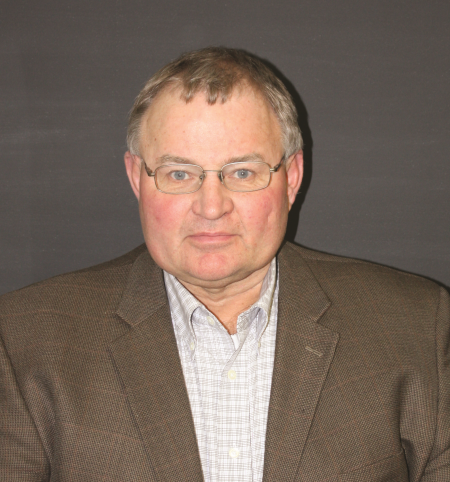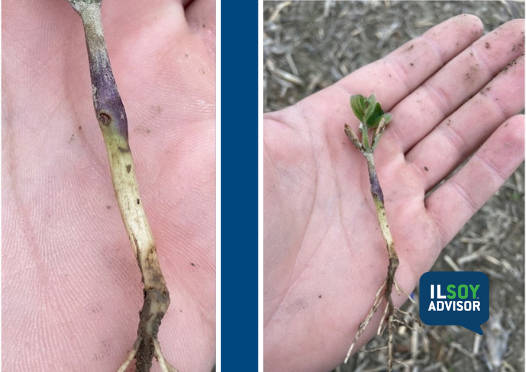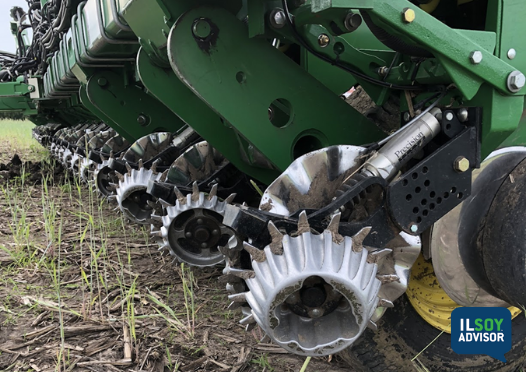ILSOYADVISOR POST
Diagnostics: Should You Plant Naked Beans in 2015?
Are seed treatments a necessary input expense in 2015? Seed treatment, depending on product combinations, can cost from a half bushel per acre to a bushel and a half an acre, so will you get enough from your acres in return? Seed dealers probably think so because they want their variety to perform and getting every seed out of the ground is an important goal. However, growers need to concentrate on cutting expenses to some degree to maintain profitability.
So is there a risk in planting untreated, ‘naked’ soybeans in 2015? Planting naked seed with no fungicide and insecticide seed treatment is one place that producers may reduce cost. But in the last 15 years treating soybean seed has become more popular with more products available, and more recognition of their value and of the ease of treating soybeans at the dealer before delivery.
Soybeans don’t always need seed treatment. For decades growers planted soybeans without any seed treatment and they got along fine. Soybeans were planted later in ideal soil conditions and at high seed rates. As a result, more seed germinated and even if some didn’t germinate, more seed was planted than necessary. Generally speaking, there are some field conditions where a seed treatment isn’t as valuable, such as planting later in warm, well-drained soils that are moist enough for germination and when heavy rains aren’t predicted for the next two weeks.
However, growers today plant soybeans as much as 2 to 3 weeks earlier than two decades ago and at much lower populations of from 120,000 to 160,000 seeds per acre. Growers are planting into soils that are cooler and wetter, fully or partially covered with residue and lack drainage. In addition, they are planting more acres in a narrow window and planting when conditions are just marginal. So are seed treatments good insurance against the risk of seed loss and having to replant?
Anne Dorrance, plant pathologist at The Ohio State University, offered these insights when considering whether to keep or forgo seed treatments in 2015 (http://corn.osu.edu/newsletters/2015/2015-04/going-naked-in-ohio).
- Farm has a history of replanting. No question, use fungicide seed treatments. Even at the older estimates of costs associated with replanting, one replant will pay for more than 10 years of a seed treatment.
- Farm drainage system has not been updated or field is slow to drain after heavy rains. More often than not, seed treatments will offer protection and have added yield benefits compared to non-treated seed. All of the soil-borne pathogens that can infect soybeans require high moisture. With a properly designed, well-maintained drainage system, the amount of time a field is saturated is greatly reduced. If the system is poor, old or not functioning well, the time the field remains saturated is much longer, resulting in more seeds/seedlings becoming infected when heavy rains do occur.
- Reduced seeding rates in 2015. This is another place where seed treatments are beginning to play a larger role; with reduced seeding rates, every seed becomes important and seed treatments can make a large contribution to maintaining early plant populations. In some of our seed treatment studies the treated seed is emerging at rate greater than 90% compared to non-treated seed, which may be at less than 50%.
- Fields with numerous pathotypes (races) of Phytophthora sojae that cause early season damping-off. We have shown over a number of studies that if you are totally dependent on the partial resistance portion of the resistance package, seed treatments are needed to protect the plants until they are up and out of the ground.
- Early planting and very cool spring. The cooler the spring, the longer the seed/seedling will sit below ground, giving these soil-borne pathogens more time to feed. For those first fields seed treatments can provide needed protection, especially when it takes 2 to 3 weeks for emergence.
Do you feel comfortable dropping seed treatments in 2015 to save money? Have you considered the cost and benefits of seed treatments as you make this decision?
Agronomist Dr. Daniel Davidson posts blogs on agronomy-related topics. Feel free to contact him at djdavidson@agwrite.com.





Comments
Add new comment